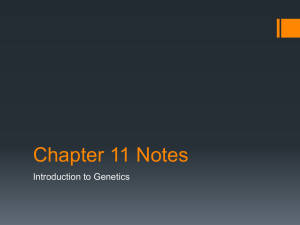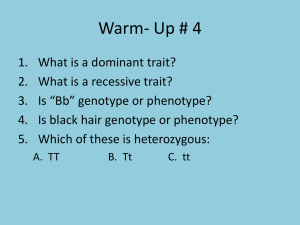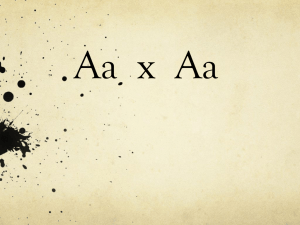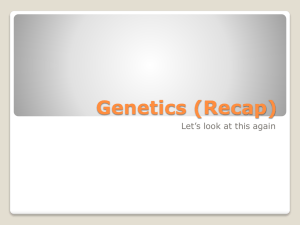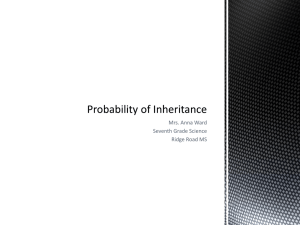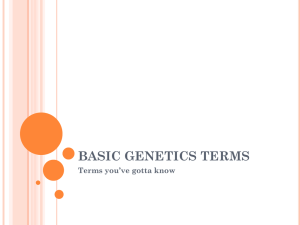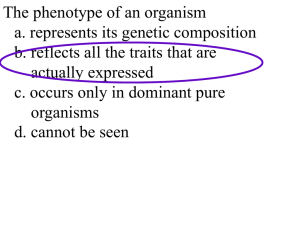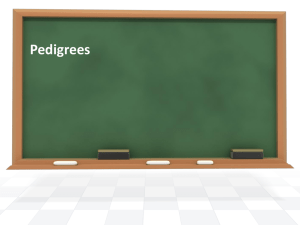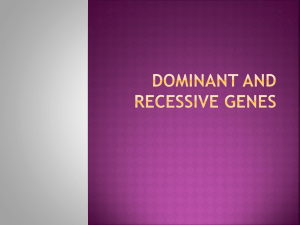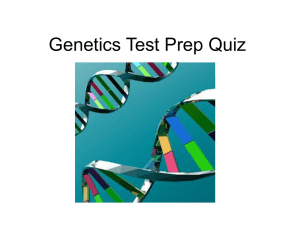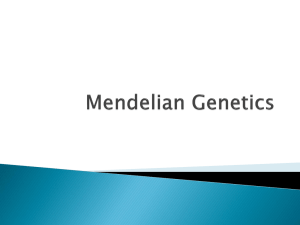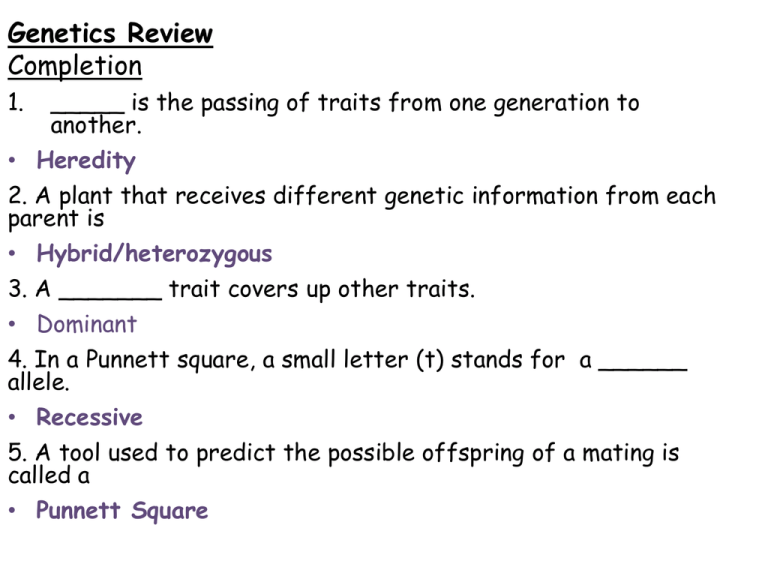
Genetics Review
Completion
1.
_____ is the passing of traits from one generation to
another.
• Heredity
2. A plant that receives different genetic information from each
parent is
• Hybrid/heterozygous
3. A _______ trait covers up other traits.
• Dominant
4. In a Punnett square, a small letter (t) stands for a ______
allele.
• Recessive
5. A tool used to predict the possible offspring of a mating is
called a
• Punnett Square
6. The genetic makeup of an organism is called its
• Genotype
7. ______ is a way an organism looks and behaves as a result of its
genotype.
• Phenotype
8. The study of how traits are inherited through the interactions of
alleles
• Genetics
9. An organism with 2 alleles that are exactly the same is
• Homozygous
10. An organism that has 2 different alleles for a trait is
• Hybrid/heterozygous
11. Describe the cause of genetic disorders.
• Mutations – a change in a chromosome or gene
12.An organism having two
different alleles for a trait is
called
a. heterozygote
b. homozygous dominant
c. genotype
d. monohybrid cross
13. The phenotype of an organism
a. represents its genetic
composition
b. reflects all the traits that are
actually expressed
c. occurs only in dominant pure
organisms
d. cannot be seen
R = round
r = wrinkled
14. Give the allele combinations for the
following
genotypes:
1. Heterozygous round seeds Rr
2. Homozygous round seeds RR
3. Wrinkled seeds rr
15. Give the phenotypes for the following
genotypes:
4. RR Homozygous/pure dominant
5. Rr Heterozygous/hybrid
6. rr Homozygous/pure recessive
16. The pedigree shows the inheritance of attached
earlobes for 4 generations.
• A. Is the trait for
attached earlobes,
dominant or
recessive?
• Recessive
• B. How do you know?
• Only 2 people out
of 14 have
attached earlobes.
17. Give the phenotypes and genotypes for all
possible offspring if a hybrid brown eyed
male is crossed with a blue eyed woman.
Bb x bb
B
b
b
b
Bb
Bb
bb
bb
Phenotype:
50% brown
50% blue
Genotype:
50% hybrid
50% pure recessive
18.
Each has a dominant gene.
Bb - hybrid
19. Use the diagram below to answer the
questions that follow.
a. Circle the sex
chromosomes.
b. What is the sex
of this person?
male
2.
100%
5%
They both have at least 1 dominant gene.
20. Study the pedigree chart below that shows
the occurrence of color blindness in three
generations of a family.
2
1
3
4
a. Is there anyone with colorblindness in
the first generation?
5
No
b. Describe the condition of the
mother in the first generation.
She is a carrier
6
7
c. How many children did the parents
in generation 1 have?
2
Study the pedigree chart below that shows
the occurrence of color blindness in three
generations of a family.
2
1
3
4
5
d. Did anyof these
children get married? If
so, which one?
Yes, #4
6
7
e. Identify which people
were colorblind in these
3 generations.
3 & 4
21. The pedigree shows the inheritance of tongue
rolling.
Is this trait dominant
or recessive? Why?
• Dominant
• 10 out of 14 people
can roll their
tongue.
22. T = Tall t = short
Give the genotype for each
gene combination:
TT: Homozygous/pure dominant
tt: Homozygous/pure recessive
Tt: Heterozygous/Hybrid
23. If an individual possesses two
recessive alleles for the same trait,
the individual is said to be
a. homozygous for the trait
b. haploid for the trait
c. heterozygous for the trait
d. mutated
24. Mendel
hypothesized that
each trait is controlled by a
factor, now called a
a. gene
b. mate
c. hybrid
d. dominance
25. A heterozygous fire-breathing dragon is
crossed with one that does not breathe fire. What
kind of offspring might they have? Give phenotype
and genotype.
Ff x ff
Phenotype:
50% fire breathing
50% no fire breathing
F
f
f
Ff
ff
Genotype:
f
Ff
ff
50% hybrid
50% pure recessive
26. Also in dragons, wings are a dominant trait. If you
crossed two wingless dragons, what kind of offspring might
they have? Give phenotype and genotype
ww x ww
.
Phenotype:
100% wingless
w
w
w
ww
ww
Genotype:
w
ww
ww
100% pure rec
27. Which sequence shows the
most complex structure to the
least complex structure?
1. gene – DNA – chromosome
2.DNA – gene – chromosome
3.gene – chromosome – DNA
4.chromosome – gene – DNA
28. Combining DNA from two different
organisms is an example of
genetic engineering
29. Combining the desirable qualities of 2
different organisms into one is
referred to as
selective breeding or hybridization
30. The process in which genetically
identical offspring are produced by
using the cells of an organism is called
cloning
31. The type of selective breeding in which
organisms with different traits are
crossed is called
Hybridization.
32. The type of selective breeding in
which organisms with similar traits are
crossed to preserve the trait is called
inbreeding.
33.
a. What does structure A represent? Gene / DNA
b. What does structure B represent? Recombinant DNA
c. What technique is illustrated in the diagram?
Genetic engineering
d. What is this technique used for?
To produce insulin, growth hormone, clotting
factors, genetically modified foods
34.
a. The letter X most likely represents
(1.) bacterial cells that are unable to synthesize insulin
(2.) human cells that are able to synthesize antibodies
(3.) bacterial cells that are able to synthesize insulin
(4.) human cells that are unable to resist antibiotics
b. What is this process an example of?
Genetic engineering
35. Genetic engineering has been
utilized for the production of
(1)salivary amylase
(2)human growth hormone
(3)hydrochloric acid
(4)uric acid crystals
36. Two heterozygous dragons are crossed. What
kind of offspring might they have? Give phenotype
and genotype.
Ff x Ff
Phenotype:
75% fire breathing
25% no fire breathing
F
f
F
FF
Ff
Genotype:
f
Ff
ff
50% hybrid
25% pure rec
25% pure dom
37. When humans first domesticated
dogs, there was relatively little
diversity in the species. Today, there
are many variations such as the
German shepherd and the dalmation.
This increase in diversity is most
closely associated with
(1) cloning of selected body cells
(2)selective breeding
(3)mitotic cell division
(4)environmental influences on inherited
traits
38.
a. What technique is represented above? Cloning
b. Which sheep is the source of the nucleus in the fused cell? A
c. Which animal is a clone? The lamb
d. Which sheep provided an egg cell? B
e. Which 2 animals are genetically identical? Why?
Sheep A and the lamb because the lamb’s chromosomes
came from Sheep A’s nucleus.
39. What does this pedigree chart
show?
a. How many people are unaffected “carriers”?
6
b. How many people are affected by the disorder?
6
c. How many carriers are female? 5
40. What does this pedigree chart
show?
a. How many people are unaffected “carriers”?
9
b. How many people are affected by the disorder?
6
c. Is the disorder dominant or recessive?
recessive
41. One cat carries heterozygous, long-haired traits (Ss), and
its mate carries homozygous short-haired traits (ss). Use a
Punnett square to determine the phenotype and genotype of
this cross.
Ss x ss
s
s
S
s
Ss
ss
Ss
ss
Phenotype:
50% long
50% short
Genotype:
50% hybrid
50% pure recessive
42. One flower is heterozygous red and it is crossed with a
homozygous dominant plant. Use a Punnett square to
determine the phenotype and genotype of this cross.
Rr x RR
R
r
R
RR
Rr
R
RR
Rr
Phenotype:
100% red
Genotype:
50% hybrid
50% pure dominant
43. KARYOTYPES
•A. Number of
sex chromosomes
2
B. Sex of this
person
male
44. KARYOTYPES
A. Number of sex
chromosomes
2
B. Sex of this
person
female
45. PEDIGREE CHARTS
a. Is this trait dominant or recessive? Explain.
Recessive because only 4 out of 14 people have the trait.
b. How many children did #’s 1 & 2 have? 4
c. How many generations are represented? 3
d. How many people have fast twitch muscles?10
46. If an egg is fertilized by a sperm with an X
chromosome, the offspring will be
A. female, XX
B. female, XY
C. male, YY
D. male, XX
47. In a pedigree chart _____.
A. a shaded circle represents a normal (unaffected)
female
B. a square represents an affected male
C. a line between a circle and a square represents a
union
D. all of the above
48.
49.
50.
51.
52.
53.
54.
100%
R
r
R
RR
Rr
r
Rr
rr
55.
50
56.
57.
58.
4
2
59.
60.
61.
62.
63.
Tt x Tt
When these 2 are crossed using a Punnett
Square, there is a 25% chance that their
offspring will be short (tt)
64.
65.
66.
They both have a dominant gene (G) so they
are both Green.
67.
Rr
rr
Rr
rr
68.
69.
70.
71.
72.
GG Gg
GG Gg
100%
gg x gg
73. Cross a person with blood type AB with
someone who has blood type O.
A
B
O AO BO
O AO BO
50% blood type A
50% blood type B
74. Cross a person who is hybrid for
blood type B with someone who has
blood type AB.
B
O
25% blood type AB
A AB AO
50% blood type B
B BB BO 25% blood type A

